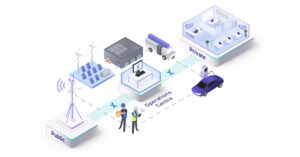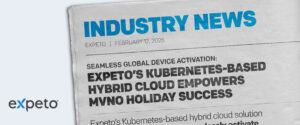I recall the 1997 Apple “Here’s to the Crazy Ones” campaign like it was yesterday. Inspired beyond belief, a fire started inside of me, fueling both the passion and courage to challenge the status quo and affect meaningful, game-changing disruption. Over the past 25-plus years, with some success and many teaching moments, I, along with my teammates, have done just that. I consider myself as crazy as ever and lucky to live in this era when the pace of innovation transforms the way we live, work and play in front of our eyes. As Bill McGowan, the founder of MCI, said in the book Failure is Not an Option, “Nothing is impossible; some things just haven’t been tried yet.”
So, what’s next? What if enterprises were able to utilize an enterprise-first, cloud-based platform designed to enable plug-and-play 5G connectivity for mission-critical business applications? Or put simply, what if there was a proverbial “easy button” that let the enterprise consume 5G on their terms?
From Fantasy…
When I say “easy,” I think of Tony Stark creating the Ironman suit. At his fingertips, he had all the required resources to efficiently design, render and integrate one of the coolest superheroes ever. If you’ve seen the movie, you know the suit — a brilliant, feature-rich, complex system managed from a single pane of glass inside the suit, leveraging information and assets from virtually every resource available globally, no matter where in the world Tony was. Equipped with over-the-air software upgrades and no downtime for one-off integrations, Tony could count on his suit to leverage the latest and greatest information and updates, ensuring it was ready to do good.
But why does this have to be fantasy? Imagine if 5G application value chains were this way.
You sit at your desk and build your 5G solution from the ground up. Think about it: a completely abstracted application, workflow and orchestration design console. An application to measure vibration for a high-value package being transported from Shanghai to Shreveport. Or an application to measure pH levels in water after a storm (and track their origins). Simply point and click to bring it together, then run off to dinner knowing you can deploy your IoT superapp as soon as J.A.R.V.I.S. finishes applying the final layer of paint.
…To Reality
We are closer than you might imagine — but it’s going to require thinking differently and a little more crazy to make it happen.
Soon, enterprise customers will be able to build, deploy, manage and — most importantly — drive valuable outcomes from digital initiatives from their very own single console. As this day approaches, consider the network that will anchor these mission-critical operations. I can picture this new breed of connectivity, equipped with a centralized control panel for easy and instant network configuration. It’ll be similar to an airplane cockpit or the interface of the Ironman suit — where all the instrumentation and control are occurring in one place to enable a fit-for-purpose network. Composable solutions will be seamlessly strung together with application and compute resources to achieve the nirvana of ultimate enterprise performance.
In regards to how global digital deployments should work, I believe the enterprise IT paradigm is one of the best models. Within the confines of the enterprise’s network, you simply add a device — point, click, done. Since each device has an IP address, you can organize the datapath, application and computing resources as well as the policy, user and administrative settings. There are no crazy one-off APIs or related special integrations, no running to multiple places asking for permissions, and no truck rolls. Generating valuable outcomes from enterprise digital transformation initiatives not only requires IT-centric speed, agility and integration, but also a total cost of ownership to drive “can’t-say-no” business cases.
To enable this leap forward, enterprises need to extend their existing IT networks with private and public 5G resources anywhere, at any time — completely integrated with their own corporate Ironman suit. Though not possible with legacy private network offerings, one compelling solution would be to leverage the reliability and range of existing public connectivity infrastructure to create a “private network experience” for enterprises. Imagine a network purpose-built to integrate and operate in an enterprise IT environment rather than proprietary and complex telco-owned options. Equipped with the power and control to manage their own networks, devices and data, enterprises could access the advantages at a fraction of the expense and complexity.
The Case For Enterprise Independence
Who can blame enterprises for wanting to control their own destinies? Indeed, their demands for seamless, low-latency, uninterrupted, and — here’s the key — affordable network connectivity solutions that fulfill the objectives of enterprises are far from new. Yet, it has taken a global pandemic to demonstrate how pressing those demands are.
Faced with an urgent crisis, it didn’t take long for the world to adjust to a new normal where applications, compute and connectivity foster the collaboration tools required to digitize our personal connections and keep the economy running. Although we hope this is a unique event from which we can recover soon, it’s also a wake-up call to suit up when required. We need to be ready to maintain continuity in the face of unexpected health and climate disasters with additional connectivity, applications and automation to ensure the essential operations that foster personal and economic perseverance.
So, maybe believing enterprises should not compromise is not so crazy after all. Because ultimately, it is their mission-critical operations and applications that depend upon their network. Shouldn’t they be the ones in control? With all their networks integrated and their entire catalog of users and devices managed from a single control plane, enterprises will be able to realize a future never before possible. And I, along with Bill McGowan, Tony Stark and countless others, am all about what is possible.
Michael Anderson is the CEO of Expeto. To learn more about Expeto’s Enterprise First solution for Private Mobile Networks, click here.
This article originally appeared on Forbes.






